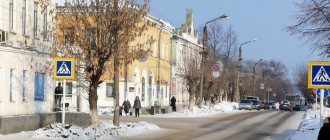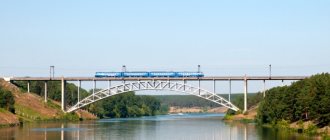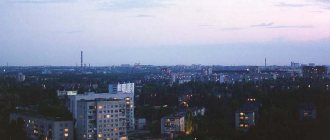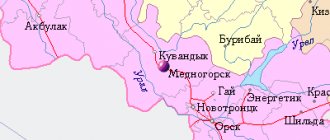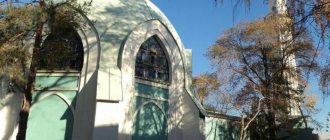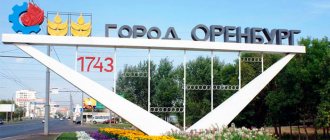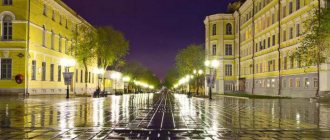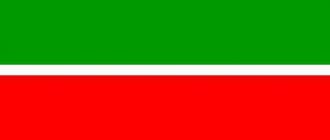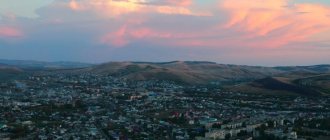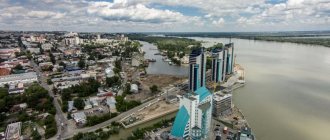Famous for the finest down scarves, the Orenburg region is located in the south of the Eastern European part of Russia. This is one of the largest subjects in the country. Satellite maps of the Orenburg region allow you to get to know it without leaving your home. You will consider borders, cities, rivers and transport routes. You can learn about attractions and find their locations. Maps are a great help for both tourists and residents of the region. The online service is indispensable when travelling.
The region has common borders with Kazakhstan, Bashkiria and Tatarstan. Also, maps of the Orenburg region with diagrams show that it is adjacent to such areas as:
- Samara;
- Saratovskaya;
- Chelyabinskaya.
Most of the land is occupied by arable land. The hydrography of the region is also extensive. There are several large rivers in the region:
- Ural;
- Sakmara;
- Samara;
- Ilek.
One of the largest natural reservoirs is Lake Shalkar-Ega-Kara. Its banks stretch for almost 100 km. Also very popular among local residents and tourists are the salt lakes in Sol-Eletsk, which are indicated on the map of the Orenburg region with its districts. This body of water is so saturated with salts that it allows you to stay afloat and not drown.
The Orenburg region is a large region with a distinctive and ancient history. If you are planning a trip to this land, use the online service with interactive maps. You can quickly find attractions in areas of the Orenburg region on the map, the location of cities and villages, and main roads.
What cities are included in the Orenburg region?
Currently, the Orenburg region includes 12 cities, two of which have populations exceeding 100 thousand people. In addition to Orenburg, this is also Orsk (231 thousand people).
The next two cities - Buzuluk and Novotroitsk - have a population of less than 100 thousand people, and are 85 and 89 thousand people, respectively.
The list of cities in the Orenburg region, where the population is less than 50 thousand people, includes the following settlements: Yasny, Abdulino, Kuvandyk, Mednogorsk, Sol-Iletsk, Sorochinsk, Gai and Buguruslan.
All cities have a different history, some of them were formed in the 18th century, when the steppes and the Urals began to be populated, and some of the cities were formed in the last century and have a poor history.
Orenburg
Video: Orenburg
Basic moments
Orenburg is located on the Ural River, at the place where the Sakmara River flows into it. The city is the administrative center of the Orenburg region. It is separated from Moscow by a huge distance of 1,441 kilometers. The population of Orenburg, according to 2022 data, is 564,443 people.
Orenburg is rightly called the largest political and industrial center of the entire Ural-Volga region, as well as a leading scientific and educational center, where a network of research institutes successfully operates. The city has a developed network of educational institutions - these are Orenburg State University, pedagogical, medical and agricultural universities, the Presidential Cadet School (by the way, the first in the country), institutes of various profiles and other educational institutions, including secondary specialized ones.
The names of many prominent personalities are associated with Orenburg: poets T. G. Shevchenko, A. N. Pleshcheev, G. R. Derzhavin and Musa Jalil, historian N. M. Karamzin, animator Harry Bardin, geologist Evgraf Fedorov, creator of fables I. A Krylov, lexicographer Vladimir Dahl, cellist Mstislav Rostropovich, prominent Communist Party figure Georgy Malenkov, former Russian Prime Minister Viktor Chernomyrdin and others. Yuri Gagarin was educated here at the flight school. A monument was erected on the avenue bearing his name, and a memorial museum was opened in the apartment in which the first cosmonaut lived. Grigory Bakhchivandzhi, known as the world's first jet aircraft tester, studied at the same flight school. Composer A. A. Alyabyev lived here in exile. Alexander Sergeevich Pushkin also set foot on Orenburg soil. The poet visited here in 1833, when he collected materials about Emelyan Pugachev, some of which were included in the story “The Captain's Daughter.”
Geography and climate
Orenburg is located at the point where two continents meet - Europe and Asia, and the city itself, thanks to the presence of a convenient railway interchange and an airport for servicing domestic and international flights, is a connecting link between them. There is even a special sign installed on the pedestrian bridge over the Ural River, symbolizing the border between Europe and Asia.
The climate of Orenburg is classified as moderate continental, turning into sharp continental. This factor directly influences the sharp fluctuations in average annual temperatures throughout the region. If, for example, in summer the air warms up to +40...+43 degrees, then in winter the thermometer drops to –45 degrees. The lowest temperature level was recorded in 1942: it was -49 degrees.
Summer in Orenburg is short but very hot. It begins in June and already at the end of August hands over the “reins of power” to autumn. Precipitation in the warm season is rare, which often leads to droughts. Autumn in the city is also short: starting in September, it gives way to winter already in November. At the same time, the first snow falls in the city, which does not melt until April.
Winter weather is not stable: periods of light frosts alternate with periods of severe frosts. The city and the entire region are characterized by strong snowstorms, gusty winds with sticky wet snow, and sometimes even rain. The occurrence of blizzards is influenced by southern and western cyclones. During the year in Orenburg you can count at least 40-50 days with snowstorms.
Spring usually arrives at the end of March, but you should not enjoy warm days ahead of time, since cold weather can return even at the end of May.
History of Orenburg
The chronicle of Orenburg, whose official founding date is considered to be 1743, is clear evidence of its unusual fate. It is the only city in our country that was founded... three times. The first settlement was founded on the banks of the Or River (hence the name), the second - in the place where the village of Krasnogor is now located.
For the third time, the city was founded in its current location, at the intersection of the Ural and Sakmara rivers. This happened on April 19 (30), 1743. The final location of Orenburg was indicated by Ivan Ivanovich Neplyuev, a Russian admiral, an actual Privy Councilor, who went down in Russian history as the organizer of the Southern Urals. Four times in its history Orenburg became a provincial and regional center, three times a district center, and from 1920 to 1925 it was even the capital of Kazakhstan. It changed its name twice: in 1938 to Chkalov, in 1957 – again to Orenburg.
Orenburg was built at the junction of the Kazakh steppes and Bashkir lands as a fortress city and a stronghold of a line of fortifications along the Yaik, Sakmara and Samara rivers, which served as an outpost on the southeastern border of Russia. It became the center of the Orenburg Russian Cossacks, established by Empress Elizabeth I Petrovna. At the same time, the city was entrusted with the mission of a center of economic and economic interaction with the peoples of Central Asia, which, first of all, implied trade relations. Therefore, in addition to the artillery yard, barracks, powder magazines and a number of other military institutions, Gostiny Dvor and customs were built.
Being a distant outskirts of the Russian Empire in the period from the 18th to the first half of the 19th century inclusive, Orenburg was used by the tsarist government as a place of exile for “people of vicious behavior.” Soldiers of the Semenovsky regiment, disbanded after the defeat of the Decembrist uprising, served their sentences here. It was in Orenburg political exile that the Russian naturalist and traveler G. S. Karelin began his life as a scientist.
After the February Revolution of 1917, which changed the entire political and social structure in Russia, Orenburg more than once became the venue for the most important political events. From July 21 to 28, the first All-Kyrgyz Congress was held here, at which the autonomy of the Kyrgyz (that is, Kazakh) regions, the forms of organizing state power in them, and land issues were discussed. In July-August of the same 1917, the first and second All-Bashkir Kurultai (congresses) were held in Orenburg, which decided to create a democratic Bashkir Republic as part of federal Russia. The central council of the congress was located in the Caravanserai inn.
After the October Revolution, on December 5-13, 1917, delegates to the Second All-Kyrgyz Congress met in Orenburg, which proclaimed the Kyrgyz (Kazakh) autonomy “Alash” as part of federal Soviet Russia. And from December 8 to December 20, the All-Bashkir Kurultai, already the third in a row, proclaimed the national autonomy of Bashkortostan.
There were truly dramatic, bloody pages in the history of Orenburg. On January 31, 1918, units of the Red Army under the command of Vasily Blyukher drove out the Cossack formations of Ataman Alexander Dutov from the city, pushing him into the Turgai steppes. On April 4, 1918, the Orenburg City Council, which occupied the building of the cadet school, was raided by White Cossacks led by Ataman Nikolai Lukin. It happened at night, they came from Nezhinskaya station and slaughtered the entire first composition of the City Council, including the families of its workers - women and children. A total of 129 people died in this brutal massacre. The Red Army’s offensive on Orenburg began only on January 10, 1919, and 12 days later its two units - the 1st Revolutionary and Turkestan - united.
During the Soviet period, the city's population increased significantly - almost 6 times compared to the pre-revolutionary period. During the Great Patriotic War, many factories were evacuated here from the central regions of the Soviet Union, which gave impetus to industrial development. In the post-war period, the Orenburg gas condensate field began to be developed, which also had a noticeable impact on economic growth.
After the collapse of the USSR, in Orenburg, as in many other cities of post-Soviet Russia, the population began to decrease. However, with the beginning of the 21st century, the situation stabilized, the economy began to develop, primarily thanks to the Gazprom Dobycha Orenburg enterprise, which turned out to be very successful in the realities of a market economy and created many jobs for the townspeople.
In the 90s, Orenburg State University and the Church of St. Sergius of Radonezh acquired new buildings. A number of sports facilities were built: the Zvezdny Ice Palace, the Gazovik Stadium and many others. The park and museum ethnocomplex “National Village” has been restored. At the same time, the military Orenburg Cossack society was revived. At the end of the last century, Gazprom built the elite cottage community “Rostoshi” in an ecologically clean area of the city, which is called one of the calling cards of Orenburg.
Sights of Orenburg
Orenburg grew out of a fortress, and its features can be seen in the modern appearance of the city, surrounded by greenery of parks. Here you can see a lot of buildings erected during the Soviet period, which are adjacent to modern high-rise buildings. The main artery of the city is Sovetskaya Street - avenues, boulevards, passages diverge from it like rays. In the everyday speech of Orenburg residents you can hear the following words: Forstadt, Dead City, Paris, New Building, Syreika, Mayak, MZhK. This is how citizens commonly call the city districts, officially called Industrial, Central, Leninsky, Dzerzhinsky.
Sovetskaya Street became pedestrian only a few years ago, turning into the Orenburg Arbat. There is not even public transport on it. Sovetskaya is notable for the concentration of historical buildings here. One of them is building No. 36, which attracts attention not only with its architecture, but also with encrypted messages. On it you can see three letters in the form of the abbreviation “PFP” and the numbers “1914”. What does this inscription mean? As it turned out, it indicates that the building was built in 1914 by the merchant of the first guild, Pyotr Fedorovich Pankratov. Confirmation of this fact can be found in newspapers of that time. From them we also learn that on this street (Sovetskaya was then called Nikolaevskaya) “a new cinema is being built,” which was given the name “Apollo Theater.” The cinema, or more precisely, the cinema, was opened in the autumn of the same year. The merchant Pankratov also owned a large trading house in Orenburg, the building of which has survived to this day; it is located at 7 Matrossky Lane.
While walking, you can go up and find yourself on the Ural embankment, from where a magnificent panorama of the river and the Trans-Ural Grove opens up. This park area, located on the Asian coast, has been a favorite vacation spot for Orenburg residents for almost 200 years. There is a beach along the coast and children's playgrounds. Residents and guests of the city are also attracted by cozy cafes and shady alleys that provide relief in the summer heat. By the way, not far from the embankment there is the City History Museum. The embankment itself, like the districts of Orenburg, also has a popular name - Belovka.
You can get to the European shore and vice versa via an iron bridge, which was erected in the 80s of the last century. But there is another way - along the cable car, which is considered one of the most modern and comfortable in our country. Along the bridge you can cross the geographical border of Europe and Asia, see the monument to the legendary pilot Valery Chkalov, as well as the Elizabeth Gate. The pedestrian bridge across the Urals deserves special mention. It, together with the descent to the river, is the main symbol of Orenburg, which can be seen on almost all local souvenirs. The white stone staircase evokes considerable admiration; it was erected in 1955, just to the right of the descent.
The Orenburg Museum of Local Lore is the oldest in the country; it was founded back in 1830. It occupies one of the most beautiful buildings in the city - the former governor's office. The ancient interiors have been restored, so the museum halls are interesting for visitors in themselves. Among the exhibits, I would like to highlight the cannon of Emelyan Pugachev’s army, the award checkers of the Orenburg Cossacks, gold jewelry from the royal tombs of the Sarmatian era, and even one of Pushkin’s four death masks. In general, the museum has over 100 thousand different exhibits.
In the Museum of Fine Arts, located not far from the local history museum, you can see a unique collection of famous Orenburg down scarves, which owe their appearance to local Cossack women. They began knitting scarves at the end of the 18th century, quickly honed their skills and brought them to perfection. Surprisingly, these voluminous-looking items could easily be pulled through a wedding ring and placed in a goose egg shell. The answer to the secret is that the local goats' down was distinguished by its fineness and extraordinary tenderness. The oldest exhibit in this museum is more than 100 years old and weighs only 40 g. Openwork “cobwebs” were a welcome gift in the royal houses of Europe and more than once received high recognition at various international exhibitions.
In the 30-40s of the 19th century, the Caravanserai was built - one of the most notable architectural monuments of the historical part of Orenburg. Stylized as a traditional Bashkir village, it consists of a main building, a minaret more than 38 meters high and an octagonal mosque (the latter is the dominant feature of the entire complex of buildings). The caravanserai, as experts note, combines the national and stylistic features of the Orenburg region. The object, which arose on the border of Europe and Asia and the junction of two architectural eras, is not unreasonably considered a striking example of both Western (European) and Eastern (Asian) artistic traditions. Immediately after the February Revolution of 1917, the main building was given over to the residence of the commissar of the Provisional Government and the Orenburg Council of Workers' and Soldiers' Deputies; later the authorities of the newly formed Bashkir Republic worked in it. During Soviet times, the Caravanserai was also not used for its intended purpose: in 1932, a club was opened in the mosque, and in 1954, a planetarium. Later, the main building was converted into the Palace of Education, and only in 1993 was it returned to believers. Currently, the Caravanserai is occupied by a Muslim religious association of the same name.
The Orenburg region is one of the most multinational regions of Russia, in which representatives of over a hundred nationalities live - Russians and Bashkirs, Kazakhs and Tatars, Ukrainians and Belarusians, Armenians and Mordvins, Germans and others. In 2004, former governor A. A. Chernyshev took the initiative to build the “National Village” cultural complex in Orenburg. The first farmstead appeared in 2006. Currently, the complex unites 10 courtyards, in each of which you can come into contact with the culture and life of different peoples. And no matter how pretentious it may sound that the “National Village” promotes interethnic harmony in the region, this is true.
Once in the center, you probably won’t pass by a unique place that combines three projects at once: “The Best People of the City”, “The Good Angel of the World” and “Walk of Fame”. Anyone interested in history and the role of individuals in certain events will find a lot of interesting information. Here you will learn about honorary residents, heroes of war and labor, about those who have achieved great heights in their professional activities. It’s not for nothing that this place is called the center of pride and glory of Orenburg.
The city has monuments to many famous people, including A. S. Pushkin and his good friend, writer and ethnographer V. I. Dal. Interestingly, on the monument the latter turned out to be a whole head taller than Pushkin. In order to somehow visually balance both characters, the author of the sculptural composition, Honored Artist of Russia, native of Orenburg N. G. Petina “put” a top hat on the first one, and left Dahl without a headdress. There are two more monuments to Pushkin in the city: the second rises near the city historical museum, and the creator of the third is the Armenian sculptor Stepanyan.
Despite the fact that Chkalov, unlike the great Russian poet, had never been to Orenburg and had nothing to do with it at all, the city bore his name for 19 years. On the embankment of the Ural River there is a 6-meter bronze monument to the legendary pilot; there is also Chkalov Street and a park named after him.
One of the most famous religious buildings in Orenburg is St. Nicholas Cathedral, built in the 19th century. Within its walls is kept a copy of the Tabyn Icon of the Mother of God, revered by believers as a Ural shrine. The original icon is three centuries older than the cathedral; it was found during the time of Ivan the Terrible, but is currently considered lost.
Gostiny Dvor is one of the famous attractions of Orenburg. Its building is located at the intersection of the main streets of the city - Sovetskaya, 9 January, Kirov and Pushkinskaya, so it is not an exaggeration to say that all roads within Orenburg lead to it. True, only the southwestern part of the “hotel” has survived to this day, which does not detract from its merits as an architectural monument. Nowadays, most of the former Gostiny Dvor is occupied by the VolgoUralNIPIgaz Institute and the dormitories of the Pedagogical University.
Local residents and tourists enjoy spending time in the numerous park areas. The oldest green area in Orenburg is the Lenin Park, located in the area of Postnikova Street. There are all sorts of trees here: pine, oak, maple, larch, ash, lilac. Such diversity gives the air of the park a special flavor and healing effect.
Another famous park is the 50th anniversary of the USSR. It is located between Brestskaya and Teatralnaya streets and Dzerzhinsky Avenue. This is where Orenburg residents and city guests prefer to spend time on citywide holidays and folk festivals. For lovers of family holidays and extreme attractions, the small Topol amusement park, located in the very center of the city, on Postnikova Street, 30, is more suitable.
On the territory of the former city garden named after Frunze there is a memorial complex “Salute, Victory!” It is an open-air museum. The memorial exhibition consists of a sector dedicated to the Battle of Moscow, the Armory Chamber pavilion and three thematic halls: “The Battle of Stalingrad”, “The Crossing of the Dnieper” and “The Battle of Kursk”. The second part of the museum is stationary: this is the “Hall of Fame” exhibition, located in the building of the regional museum of local lore.
What to bring as a souvenir
Of course, legendary down products! Folk craftswomen still knit them, passing on traditions from generation to generation, and in each village the process of making an Orenburg scarf has its own characteristics, although in general it has remained virtually unchanged for hundreds of years.
It is better to buy not only scarves, but also other local down products (scarves, mittens, socks, stoles) in the markets. Many people who want to buy or sell this kind of product gather early in the morning. When choosing the right one, trust your feelings: Orenburg down is usually soft and warm, which distinguishes it, for example, from the prickly Angora and shaggy Volgograd. An important criterion when choosing a “fluffy” souvenir is the price. The cost of stoles starts from 700 rubles, the starting price of warm scarves is even higher - 1,500 rubles. Not everyone can afford designer “cobwebs”; their cost can be several tens of thousands of rubles.
Products made from malachite and jasper are also popular among tourists, and this despite the fact that the Orenburg region is a predominantly steppe region, with small mountain ranges found only in the eastern regions.
Football fans who come to Orenburg are also not left without pleasant souvenirs. Badges, T-shirts, keychains, mugs, scarves and other products with the attributes of the Orenburg football club, which until 2016 was called FC Gazovik, are in great demand among fans of this sport.
The most delicious desserts in the city, and primarily cakes and pastries, are made in the Winnie the Pooh confectionery. Those with a sweet tooth especially like baskets and eclairs, the delicate taste of which evokes nostalgia for childhood. Among the signature cakes of this confectionery, I would like to highlight “Don Pancho”, which even those who do not have a great craving for sweets enjoy trying.
Shopping lovers should visit the Armada shopping and entertainment complex, the largest and fastest growing not only in the city, but also in the region. Under its roof there are 250 shops, ranging from small boutiques to hypermarkets. “Armada” is also one of the most competitive in Russia and occupies an area of 150 thousand square meters. On weekends, this shopping and entertainment complex offers a variety of activities for the whole family. For several years in a row, a holiday called “Night Shopping” has been taking place here, attracting tens of thousands of buyers.
Hotels and accommodation
Most hotels in Orenburg offer guests good conditions at very affordable prices. Tourists will also find it affordable to stay in standard rooms in modern four-star hotels.
An excellent and inexpensive option is the Sulak hotel complex, located just 8 km from the city center. Here you will be offered a choice of double standard rooms of the first and second categories, triple rooms and luxury apartments. They are decorated in warm colors, equipped with the necessary furniture and equipped with a bathroom. The hotel has a sauna and a swimming pool, and the banquet hall has all the conditions for holding various celebrations. The cost of living is from 600 rubles per day.
The modern GrandHotel, opened in 2012, is located 3.5 km from the railway station. The rooms are designed in an elegant classic style. The apartments are, without exaggeration, luxurious, like in a palace, and living in them, coupled with a high level of service, will make you feel like a real VIP. The hotel has a restaurant. Guests can also take advantage of laundry, dry cleaning and free secure parking. “GrandHotel” also attracts tourists due to the fact that many city attractions, shopping and entertainment centers are located close to it. A night's stay will cost no less than 2,500 rubles.
The modern Armada Comfort Hotel, located 8.5 kilometers from the historical center, offers guests of Orenburg a comfortable stay in elegant rooms. You can choose from rooms of such categories as “standard” (double and triple), “luxury” and “super-luxury”, as well as double VIP. The hotel has a cozy cafe and free parking. Free Wi-Fi is available throughout the hotel. Services such as ironing and taxi calling are also available. The cost of living per day starts from 1500 rubles.
Tourists who want to travel economically can use one of the best options - the Usadba Hotel. It is not necessary to stay here overnight or for the whole day: you can rent a room for only 3 hours and inexpensively, for only 500 rubles. For those who decide to stay here for more than 5 days, a special discount system is provided. Each room has free internet. There is a cozy restaurant on site.
Among the most inexpensive hotels in Orenburg is the Columbus, where a night’s stay will cost only 400 rubles. This opportunity to save is ideal for those who come to the city on a business trip, to look for work, or just to stay for a few days and see the sights, without wanting to spend a lot.
Orenburg also has its own inexpensive hotel-hostels, the living conditions of which resemble a hostel. One room can accommodate from 2 to 10 people at a time. Guests have access to a shared kitchen, bathroom and toilet. If necessary, the staff can provide a kettle, plates and even a saucepan. These hostels include “Alaska”, the UDPO dormitory and “Apartments on Prostornaya Street”. A day in such hostels costs from 200 to 700 rubles.
Booking.com
How to get there
Orenburg is one of the largest transport hubs in the entire Ural region. 19 km from the city is the Yu. A. Gagarin International Airport, which can be reached by bus, minibus or taxi. The air harbor receives flights from Moscow, St. Petersburg, Yekaterinburg, Kazan, Perm, Omsk and other cities. Departures from the capital of Russia are carried out from Domodedovo and Sheremetyevo airports, travel time is about 2 hours.
Orenburg has railway connections with cities such as Moscow, Yekaterinburg, Chelyabinsk, Ufa, Samara, Orsk, and Adler. In addition, it is located at the intersection of several railway transport lines leading to Aktyubinsk, Samara, Ufa and Orsk, which allows travelers from different regions to get to Orenburg without transfers. From Moscow you can get there by. The journey from the capital to the homeland of the famous down scarves will take 25-26 hours.
The Orenburg bus station serves routes from Yekaterinburg, Orsk, Naberezhnye Chelny, Kazan, Perm, Samara, Magnitogorsk, Ufa, Tolyatti, Yasnaya Polyana and Kazakhstan's Aktyubinsk and Uralsk. There is no way to get directly from Moscow: residents of the capital will first have to get to Kazan and change to an intercity bus there. The bus service between Orenburg and the capital of Tatarstan includes several trips per day.
You can also get to Orenburg by private car. The P239 highway runs through the city, which originates in Kazan and stretches to Akbulak and the border with Kazakhstan. From Moscow by car you need to travel along the M7 Volga highway, passing through Vladimir, Nizhny Novgorod and Kazan. Having left the capital of Tatarstan, you should turn onto the P239 highway.
Calendar of low prices for air tickets
Cities of the Orenburg region: list by population
As mentioned earlier, the largest are Orenburg and Orsk, which appeared in 1743 at the same time. 49 and 35 thousand people live in Buguruslan and Gai, respectively. Buguruslan has a rich history, was founded in 1748 and is the administrative center. It was built as a settlement, but in 1781 it received the status of a county town.
The list of cities in the Orenburg region with a population of less than 30 and more than 20 thousand consists of four cities: Kuvandyk, Mednogorsk, Sol-Iletsk, Sorochinsk. The most famous is Sol-Iletsk, which is famous for its salt and mud lakes, where millions of people come every year for treatment of various diseases. It is also worth noting Mednogorsk as the industrial center of the region, where there are more than 20 factories. It is one of the most polluted cities, mainly due to the copper-sulfur plant, which emits sulfur dioxide and settles above the soil, forming sulfuric acid. As a result, the population is declining every year. Once it had 39 thousand inhabitants, and today it is 25.
Churches, cathedrals and temples
Orthodox Saraktash Convent of Mercy
Address: Saraktash village, st. Pushkina, 77 Phone: 8 (35333) 6-12-32 and Website: stobitel.ru Cost: children - 50 rubles, adults - 100 rubles. per excursion Opening hours: excursions by arrangement
The Saraktash monastery is called the Vatican of the Orenburg region. The largest Orthodox complex in Russia was founded in 1990 on the basis of the Intercession parish. That year was special for this place.
- The icon of the Mother of God was updated: printed at the end of the 19th century, the image darkened so much that the outlines of the Mother and Jesus became indistinguishable. Then it was decided to replace it. But a miracle happened: a few days later the faces of the saints brightened. And then gradually the whole icon.
- After long negotiations, the building of the former Church of Semeon of Verkhoturye, where the kindergarten was located, was returned to the church.
- A young priest, Nikolai Stremsky, arrived in Saraktash. At that time the monastery owned only a small prayer house.
By the way, Nikolai’s father’s family is the largest in Russia. He has 72 adopted children.
Holy Tikhvin Mother of God Convent (Buzuluk)
Address: Buzuluk, st. Sergo, 1 Phone: 8 (35342) 2-33-15 Website: buzulukjenmonastyr.prihod.ru
“The chosen vessel,” said the great elder Seraphim when he saw the peasant girl Euphemia Ovsyannikov. After such a blessing, she dedicated herself to the Lord and founded a women's community, which later received the status of a monastery.
During the years of Soviet power, its churches were used as a power plant and warehouses. The cells turned into cells of a transit prison, where prisoners were tortured and shot. In one of them, the locally revered schemamonk Maxim suffered martyrdom.
After the Great Patriotic War, the monastery began to be revived: the All Saints Church was opened. In 2000, it was transformed into the Tikhvin Convent.
Catherine's Church in Tugustemir
Address: s. Tugustemir, st. Tserkovnaya, 5
The Church of the Great Martyr Catherine was built by titular councilor Viktor Zvenigorodsky in memory of his wife, who died of consumption. Bricks for construction were made three kilometers from the future temple in a neighboring village.
According to legend, they were delivered to the construction site in an unusual way: they were passed along a chain from hand to hand.
The facade of the temple was decorated with 12 plaster apostles. A bell tower 43 meters high was built nearby. During the Soviet period, the temple was closed and partially destroyed.
To date, restoration work has not been completed.
Church of the Transfiguration of the Lord in Orsk
Address: Orsk, st. Stepana Razina, 100a Phone: 8 (35372) 6-60-51 Website: prihod.orsk-net.ru Opening hours: Mon-Sun 07:00-19:00
The temple has changed 3 locations throughout its history. It was moved twice due to floods until it was built on the mountain. But even here he did not stand for long - there was a fire. The building was restored, but this time made of stone.
Construction was timed to coincide with the visit of Nicholas II. The temple was created as a symbol reminiscent of this event.
But in 1934 it was dismantled, leaving only the bell tower, which was used for the needs of firefighters. It was revived in 1993.
Temple of the Archangel Michael
Address: s. Gorodishche Phone: Website: gorodische-orenburg.prihod.ru
The history of the temple begins with the construction of a wooden church in 1836, but it did not stand for 50 years - it burned down. In 1880, a new stone building was laid.
The whole village built, bricks were delivered to the construction site by hand. Young people even brought them to the future temple before the festivities. In Soviet times there was a grain storage facility, a tractor repair shop and warehouses.
- Here is the miraculous icon of the Most Holy Theotokos “Quick to Hear.”
- The temple contains the relics of Mary Magdalene, the Great Martyr Panteleimon, St. Seraphim of Sarov and many others.
If you have not yet chosen where you will live and want to save money when booking, we recommend using the RoomGuru service. Firstly, it contains hotels, apartments and guest houses from many different booking systems, so you won’t miss out on a worthwhile option. Secondly, you can immediately compare prices for one place in different services and book where it is cheaper (this is not always Booking!).
The smallest cities
The list of cities in the Orenburg region closes with small population centers where less than twenty thousand live - Yasny and Abdulino, 15 and 19 thousand people, respectively.
Abdulino is an ancient town, founded in 1795 as a village. At that time, 37 people lived in it. Only in 1923 the village received city status. Several factories, elevators and mills were built here, and by that time already 15 thousand people lived.
In 1961, when an asbestos deposit was discovered, the city of Yasny appeared, which first had the status of an urban-type settlement, and in 1979 became a city.
Historical places
Museum-reserve of S. T. Aksakov
Address: s. Aksakovo, st. Aksakovskaya, 85 Phone: 8 (35352) 5-31-68 Website: aksakov-museum.ru Opening hours: Tue-Sun 10:00-18:00, Fri 10:00-21:00; lunch 13:00-14:00 Cost: children - 20 rubles, adults - 50 rubles; excursions from 150 rub.
The S. T. Aksakov Museum-Reserve is the estate where the writer spent his childhood and part of his youth. In the 1940s, its territory was given over to a machine and tractor station for housing and vegetable gardens for workers. As a result, some buildings were destroyed and some alleys were lost.
Currently, the house and outbuildings have been restored. The property also includes a pond with fishing facilities, a chapel and a park. The museum conducts:
- 18 excursion programs;
- Aksakov Readings;
- theatrical registration of marriages.
Complex "Red Mountain"
Coordinates: 51.827104, 56.372055 Address: Saraktashsky district, village Vasilyevsky Telephone: Website: krasnaya-gora.orensau.ru Cost: 50 rubles. from the car, 10 rubles. per person How to get there: by personal transport or minibus; the nearest settlement is Tatarsky Saraktash (10 min)
On the right bank of the river. Sakmara is the Red Mountain. Its second name is Saraktash, which means “stone sheep.” This is explained by the fact that one day travelers from afar mistook the large stones with which the mountain was strewn for a flock of sheep.
There is a fortress at the top. Red Mountain owes its appearance to the filming of the film “Russian Revolt” based on “The Captain’s Daughter” and “The History of the Pugachev Rebellion” by A. S. Pushkin. All the buildings in the complex are wooden: houses, mills, churches, wells.
After the work was completed, the film set turned into an open-air landscape and ethnographic museum. At its base there is a hotel complex and a restaurant.
Landscape Park Luna
Coordinates: 53.067520, 54.541233 Address: Sharlyk district, Luna village Opening hours and cost: by agreement
The park, located in a small village, was created by local residents. It is located on the shore of the lake and is designed in the style of Novgorod Rus'.
At the entrance there is a large carved gate, behind which one can see wooden houses, gazebos and a mill. The mill, by the way, performs a purely decorative function, but its blades spin in windy weather.
The area is private, but tourists are welcome here.
